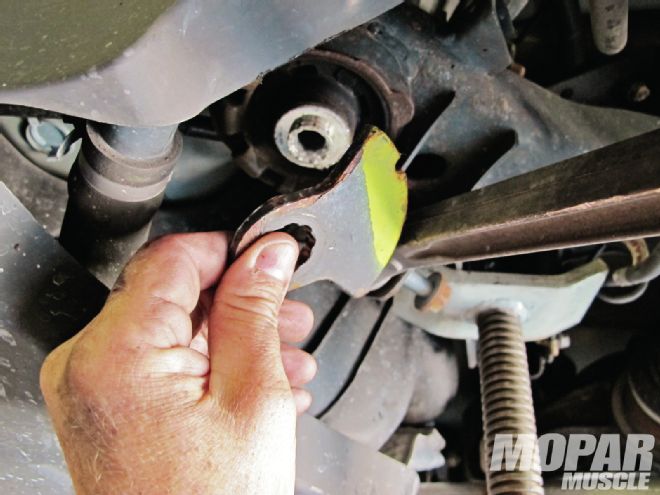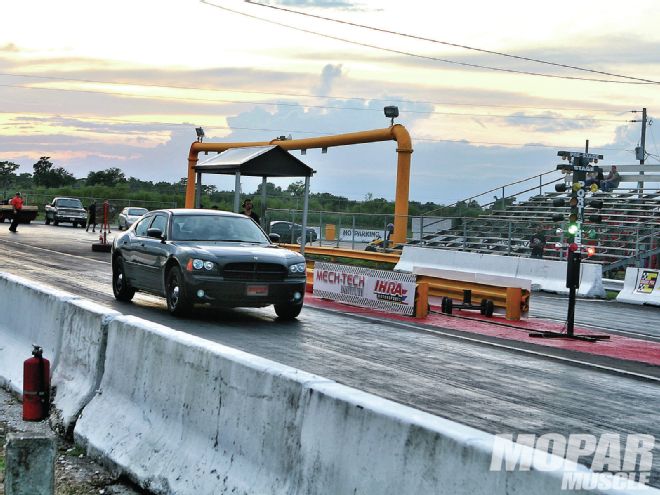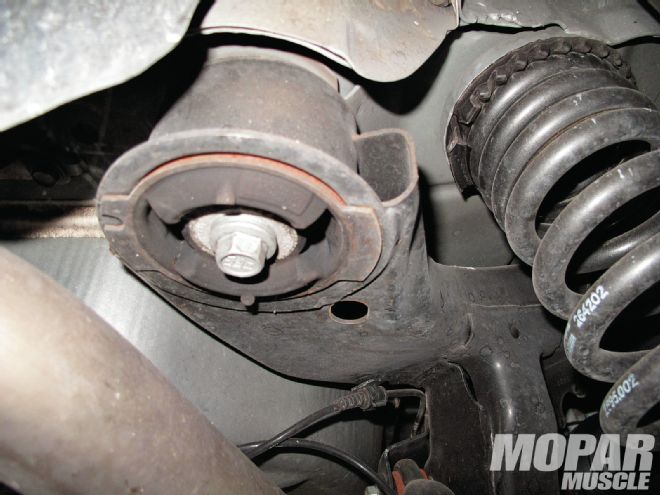
 An Independent rear suspension is an advantage in many ways, but when it comes to acceleration, independent rear suspensions can cause wheel hop and traction loss. This month we’ll correct that issue by installing upgraded parts from Hop Not.
An Independent rear suspension is an advantage in many ways, but when it comes to acceleration, independent rear suspensions can cause wheel hop and traction loss. This month we’ll correct that issue by installing upgraded parts from Hop Not.
Performance, styling, and the Hemi engine are all features common to both late and early Mopars, but there are some things about Chrysler's new performance offerings that have nearly nothing in common with the classic Mopars we love. Sure, the new Mopar vehicles have many similarities to the Mopar cars built during the sixties and seventies, but looks and nameplates can be misleading. In many ways, these late-model Mopars are far more advanced than our older muscle cars, with amenities such as satellite radio and navigation that weren't even available when the first Road Runners or Challengers rolled off the assembly line. And with computers controlling the engine's fuel injection and ignition system, as well as the transmission and even the vehicle's traction, there's no doubt that these advancements make the latest Mopars amazing performers, while also being a pleasure to drive. One area of the new Mopar LX platform cars that helps in many ways is the independent rear suspension. Unfortunately, while there are many advantages of independent rear suspension there's also one disadvantage. During hard straight-line acceleration, these cars can have a tendency to spin the tires, resulting in wheel hop.
As the name implies, independent rear suspension means that unlike our older Mopars which incorporate solid rear axle housings, each wheel of a modern Mopar can move up and down independently of each other. To facilitate this independent movement, the center section of the differential is essentially a part of the rear frame and doesn't move. Individual axle shafts that incorporate universal joints on each end allow each rear wheel to travel up and down without transferring the motion to the other wheel. In many ways, independent rear suspension benefits the performance of a car by allowing each rear tire to remain planted firmly on the road surface during cornering and braking, and while accelerating over rough surfaces or around curves. Independent rear suspension also provides improved ride quality, but when accelerating straight ahead, like when drag racing, independent suspension is more prone to inducing wheel hop when traction is marginal.
 01. The rear cradle holding the independent suspension to the car is held in place by large, soft rubber bushings. While these bushings likely improve ride quality and dampen harmonics, they allow the entire rear cradle to move, which is counterproductive in terms of straight line or cornering performance.
01. The rear cradle holding the independent suspension to the car is held in place by large, soft rubber bushings. While these bushings likely improve ride quality and dampen harmonics, they allow the entire rear cradle to move, which is counterproductive in terms of straight line or cornering performance.
Wheel hop can happen in any car where traction is an issue, but cars with independent rear suspensions like the new Dodge Challenger, Charger, and Chrysler 300 have a rear suspension cradle that is attached to the rest of the car using four large rubber bushings, making matters even worse. These large OEM bushings allow the rear cradle, and thus the entire rear suspension, to move around during both normal and aggressive driving conditions, and especially during acceleration. Fortunately there's a company called Hop Not that has engineered a solution to wheel hop issues found in late-model Mopars. Hop Not offers two kits for the rear suspension of late-model Mopars. The first of which is called the Stage I kit, and it eliminates the movement of the rear cradle associated with the OEM rubber mounts.
The Stage I Hop Not kit truly is a bolt-on upgrade, involving the installation of CNC produced spacer plates in conjunction with the OE bushings, virtually eliminating the movement of the rear cradle. Since the plates on each side are installed individually, there's no need to drop the cradle from the car or worry about rear end alignment when installing the Hop Not parts. In addition to helping eliminate wheel hop, the Stage I kit also helps the car's handling and braking by eliminating cradle movement. A quick visit to hopnot.net, Hop Not's website, will allow you to view videos showing the large amount of movement the OEM rubber cradle bushings allow, as well as the dramatic increase in movement once the Stage I kit is installed.
The Stage II Hop Not rear suspension kit can only be installed after the Stage I kit is already in place, and involves mounting horizontal bracket stabilizers and proprietary upper and lower mounting brackets. Stage II is also a bolt-on upgrade, and doesn't require the cradle to be dropped or any specialty tools. The Hop Not rear suspension kits are available for all LX platform rear wheel drive Mopars, and compatible with both automatic and six-speed equipped cars. Kits for six-speed equipped cars are slightly more expensive due to the adjustable sway bar end link that is included. In addition to kits for cars with factory ride height, Hop Not also offers kits for cars that have been lowered, and even offset brackets to accommodate larger than stock rear tires. After researching Hop Not's products, watching the videos, and reading the testimonials on the Hop Not website, we decided to test these products for ourselves and ordered the complete Stage I and II kit for Associate Editor Scott Ross' automatic transmission equipped 2007 Dodge Charger police package car (basically a Charger R/T).
Prior to installing the Hop Not rear suspension components, we took Scott's Charger out to the Stingray Dragway in Lakeland, Florida, to get some 60 foot times. Launching the car with the traction control off and the engine at 1,600 rpm at the line, we didn't experience any real tire spin or wheel hop, but once we pushed the launch rpm up a little, we started spinning the tires not so much off the line, but 20-30 feet down track. Our first two passes launching at 1,600 rpm resulted in 60 foot times of 2.170 and 2.149 seconds respectively. Launching at 1,800 rpm for the third pass netted a 2.124-second 60 foot time, but we could tell the car was right at the edge of losing traction with just a hint of wheel hop beginning about 30 feet from the starting line. Subsequent attempts to launch the Charger at higher rpm netted tire spin off the line, wheel hop about 20 feet out, and slower 60 foot times. With our baseline established, we headed to the shop.
One thing we noticed during this installation was the clarity of the instructions included with the kits. These instructions included step by step written directions, as well as close-up color photos of each step and a list of all the tools needed for the installation. Following the instructions and with our car on a two post lift we installed the Stage I kit with little difficulty, and the kit could easily be installed with the car on jack stands if you don't have access to a lift. Moving on to the Stage II kit, we again followed the directions and had the horizontal stabilizer brackets and shocks installed without any trouble. The most time consuming (and frustrating) part of this install is trimming some of the OEM rubber bushing away so the Hop Not components would bolt on properly. Even so, the complete installation was easily accomplished in about 3-4 hours and the car was ready for the road.
After completing our installation, we took the Charger back to the drag strip to get some results. Even on the drive to the track it was apparent that the rear of the car seemed more connected to the rest of the vehicle, and handling was noticeably improved. At the track we made several passes, progressively increasing our launch rpm, and immediately noticed that the car seemed stiffer and reacted quicker. Unfortunately for us, there had been rain earlier in the day and the track was not nearly as sticky as when we made our baseline runs. Even worse, we had to drive the Charger through several areas of standing water on the return road, as did the other racers, and a fair amount of that water made its way onto the track.
Even with the terrible traction, we still managed some decent 60 foot times, given the questionable track conditions. Although the tires were definitely breaking loose easier due to the moisture on the track and in the fenderwells which was certainly dripping onto our tires, 60 foot times were a respectable 2.176 and 2.175 seconds on our best launches at 1,600 rpm. Any launch rpm higher than 1,700 and the car would simply spin slightly off the line and then haze the tires out about 40 feet or so resulting in slower 60 foot times. Another testament to the Hop Not components was that even if we pushed the Charger to moderate or heavy tire spin, the wheel hop that was apparent during our baseline testing had gone away and the car tracked straight. This driver's feeling is that if the track conditions were the same as when we base-lined the car, we could have certainly improved our times. More importantly, we did all of our testing on stock tires, and now that the Hop Not suspension is installed, the Charger would surely benefit from tires with a softer, stickier compound.
For the cost and time, we'd consider this upgrade mandatory if you like driving your late-model Mopar aggressively in either a straight line or around curves. The soft rubber OEM rear cradle bushings simply allow too much movement in the cradle for vehicles with so much performance potential. We'll keep you posted once we re-test Scott's Charger on a better surface, and certainly once we get some stickier tires for the car. Be sure to check out moparmuscle.com as well to see video of our test session.
Price tag Part Cost Hop Not Stage I rear suspension $240 Hop Not Stage II rear suspension $350 Stage I and II purchased as kit $502